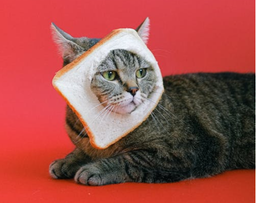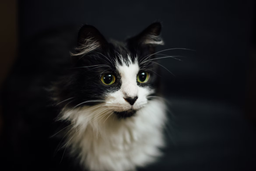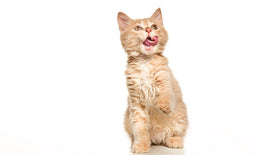Are the workings of insect cat food bugging you? Untamed unravels the buzz!
Put “insect” and “food” together in a sentence, and you are likely to wince and utter “yuck!” But creepy-crawly bugs aren’t outlandish food for cats once you consider their natural diet in the wild.
Insect-based cat food—usually called insect cat food—essentially includes products infused with proteins harvested from farmed insects. It is not quite conventional yet, and it’s primarily marketed as an alternative meal tailored for kitties allergic to traditional cat food.
The insect cat food industry is relatively small, with a limited range of products and low mainstream visibility, making it hard for cat parents to gather relevant information on the subject. In this unbiased guide, we will answer the following questions:
- What is the nutritional profile of insect cat food?
- Is an insect-based diet safe according to vets?
- How does it compare to regular wet food?
- Is insect-based food an appropriate long-term solution?
What’s the logic behind insect-based cat food?
A wild cat would hunt and eat whatever they can lay their paws on, usually small critters like mice, slugs, birds, and insects. While they are not entirely dependent on insects, it’s still part of their diet. Since cats can harness proteins, healthy fats, vitamins, and minerals from insects, some people think it’s okay to feed them insects regularly.
The concept of insect-based food may seem super fancy on paper, but most veterinarians have expressed heavy scepticism on these experimental products. Cats are hardwired carnivores, so meat is essential for optimum organ function. If you deviate from their ancestral diet of whole meat and give them grains, milk, plants, veggies, or insects as regular meals, their health and general wellness can suffer in the long run.

You say my lonely ancestors ate these spooky-spikey, crawly thingies when they had no food available? That’s sad! I’m glad we’re allies now, hooman, and that I don’t have to worry about food anymore.
Source: joudrierd
Is cat food made with insects safe?
The safety of insect cat food is questionable. Insect-based products are not pureed insects but a processed concoction of insect matter and fillers. According to Pet Food Manufacturers’ Association (PFMA) guidelines, the industry can use insects as feed in three forms:
- A rendered meal—Rendering (or processing) edible insects is the most popular way of extracting proteins from them. A rendered insect meal is usually a powdered mixture of various heat-dried insects. The derivative can be added to biscuits and gravy food for both cats and dogs
- A frozen pâté—Insects are made into a raw paste and conserved by freezing. The mixture is commonly used for wet and semi-moist products along with other proteins like chicken and fish meals
- Whole dried—Whole dried insects are also available as feed, but they are more suitable as bird food
These guidelines are conveniently generalised for all domesticated animals, which means pet parents should discern whether a particular feed is suitable for their pet or not. Insect feed is more fitting for omnivores like dogs or insectivore pets like geckos, opossums, and nightingales. Using it in cat food is a novelty, and there aren’t enough reliable studies to back up the safety or effectiveness of insect-based diets for felines. It’s ultimately a risky move that can potentially compromise your kitty’s well-being.
Is insect cat food expensive?
The short answer is yes, and there’s every reason for it. Due to the restricted supply chain, insect protein-based products are generally pricier (almost double or triple) than your regular cat food.
The European Union has authorised the use of seven species of insects in pet food, with the following three dominating the industry:
- Black soldier fly (BSF)
- House crickets
- Yellow mealworms
These insects are harvested in about 100 small farms spread across the UK, Belgium, Poland, Holland, and France. The cost of running these farms and transporting raw materials is steep, and the suppliers must sell their produce at exorbitant prices to see a glimmer of profit.
Is insect cat food nutritious enough for cats?
The nutritional profile of insects varies and depends on the species and stage of metamorphosis (i.e. whether they are harvested as larvae or mature insects). Let’s check out the approximate nutrient content in common feed insects:
|
Nutrient |
Crickets |
Mealworms |
BSFs |
|
Proteins |
58% |
52% |
50% |
|
Lipids (Fats) |
16.7% |
30% |
35% |
|
Carbohydrates |
7% |
3.4% |
8%–12% |
An ideal cat food product should contain:
- High protein content (more than 50%)
- Moderate fats (up to 20%)
- Minimal to no carbs (should be less than 3%)
Based on these markers, insect-based cat food may have okay-ish protein levels, but the content of carbohydrates and fat is way higher than desired. A high-carb, high-fat diet can lead to rapid weight gain in sterilised cats, especially in laid-back breeds like Persians, Ragdolls, and British Shorthairs.

I thought you cared. What am I to you, hooman? A lab rat?
Source: Fotobox_Petra0107
Cat food with bugs and tiny critters—does it offer practical benefits?
While consumer acceptance is still a problem for insect-based products, some buyers favour them for three primary reasons:
- Environmental sustainability and food security
- Allergy management in pets
- An alternative to the controversial vegan diet for cats
Let’s examine whether insect cat food can help with these issues in detail.
Can insect cat food help with sustainability and food security?
Many environmentalists push insects as the protein of the future, not only for cats and dogs but for humans as well. It should be a sustainable alternative because harvesting insects requires fewer resources (land, feed, water, fertilisers, etc.) than rearing poultry and livestock.
The process of farming insects generates minimal greenhouse gases, which automatically lowers the industry’s carbon footprint. Another benefit is the short life-cycle of insects—you can harvest proteins from insects within 10–14 days, so the production volume and frequency are pretty high.
These upsides sound fantastic in theory, but the harsh truth is that we may need to cut down forests and free up more land for insect farming on a profitable scale, which doesn’t sound so sustainable, does it?
Hidden beneath the perceivable economic and ecological advantages, there’s also a business angle to using insects in pet food. Market experts believe that switching companion animals to insect-based food would free up 20% of the annual meat output, and the surplus can, in turn, be exported for larger profits.
How to manage allergies in cats—expensive insects or basic diligence?
Cats with severe food allergies are typically recommended novel proteins, i.e. proteins they haven’t been exposed to previously. Proteins from expensive sources like insects, kangaroo, ostrich, and rabbits are often suggested, but you can use something as basic and accessible as chicken or turkey as a novel food option. It’s all about knowing what works for your pet.
Managing allergy in cats comes down to recognising the allergen, which can be:
- A particular protein source—If a cat is allergic to a specific protein source, say beef or dairy, they usually do well on tuna and chicken
- One or more grains—Sweetcorn, rice, and wheat are common allergens in cat food. You need to switch to a grain-free product in such cases
- An additive in cat food—Wet and dry food can be loaded with artificial ingredients serving as taste enhancers, preservatives, and colouring. If your kitty is allergic to such additives, switch them to a hypoallergenic product

I’m allergic to double standards…and the fact that I have no power over choosing what I eat. Do you have any idea what I really like?
Source: catsofbath
Cats can be allergic to anything under the sun. Keep an eye out for the following signs to know if a product is is not appropriate for your kitty:
- Vomiting digested or undigested food
- Stomach sensitivity and diarrhoea
- Retching
- Excessive shedding
- Red, tender skin
- Anorexia
- Wheezing
- Inflamed paws
Insect cat food or a vegan cat diet—which one makes more sense?
Many vegans are adamant that cats can thrive on plant-based proteins. Unfortunately, meat-free diets cause taurine deficiency, which is lethal for cats. Insect food is heavily marketed as an alternative food for vegan pet parents who want a “cruelty-free” meal for their furry companion.
Insects are also animals, so the humane argument is groundless. Cats have evolved to process and absorb nutrients from meat, and forcing any other diet on them would be cruelty, if not negligence.
What are the risks of switching to insect cat food?
Domesticated cats need animal protein and fat to stay healthy and happy. It’s irresponsible
to jeopardise their well-being by feeding them experimental, lab-synthesised products with exogenous proteins. Diets with low-quality proteins can cause numerous health problems in felines, including:
- Weak bones, teeth, and muscles
- Frequent hairballs
- Gastrointestinal issues like constipation and IBS
- Poor appetite
- Weight fluctuations
- Slowed metabolism
Another problem with insect cat food is the potential unavailability of products. Insects are widely consumed in parts of Asia, Africa, and Central America, but they are still taboo in the rest of the world.
Most pet parents in the UK are reluctant to feed insects to cats when there are better options available. The supply chain in most Western countries is still unstable, so you may have to switch products often, exposing your kitty to unnecessary stress.
Insect vs regular wet food—an honest assessment
When assessing cat food, nutritionists like to test the bioavailability of the protein. Bioavailability is the rate and extent to which the feline digestive system can absorb the nutrient. As a general rule, proteins in whole meat offer higher bioavailability than processed proteins. Since most insect-based products are biscuits made with processed insect meals, the bioavailability of the protein is low.

Dry food infused with insect proteins—Fly or sly, or a sight for sore eyes?
Source: Johnny_Harvester
The table below outlines the bioavailability of various protein sources used in cat food:
|
Protein source |
Bioavailability rate (approximate values) |
|
98% |
|
|
Chicken liver |
92% |
|
Salmon, sardine, prawn, and tuna |
94% |
|
87% |
|
|
Soya chunks or soya milk |
68% |
|
Processed proteins (including vegetable proteins, meat derivatives, fish, and insect meals) |
Under 65% |
Based on these values, insect dry food, or any dry food made with processed proteins, is a nutritionally suboptimal meal. Regular biscuit-consumption causes dehydration, ultimately leading to kidney ailments, bladder stones, urinary tract infections, etc. Dry food tends to be high in carbohydrates, so overconsumption creates a calorie surplus and contributes to feline obesity and diabetes.
According to top nutrition specialists, cats are healthiest when fed a regular diet of complete wet food in suitable portions.
Find comfort in reliability—choose Untamed wet food!
Trends in cat food come and go, but nothing beats the benefits of a whole-meat diet. Untamed offers gravy and jelly products that meet your kitty's nutritional needs. Our meals are easy to digest and delicious.

Untamed offers dependable nutrition—our meals keep your cat fit and in good spirits!
Image (c) Untamed
Untamed products are:
- Made with human-grade ingredients—Cat food is often loaded with cheap meat derivatives unusable in the human supply chain. We use real human-grade meat full of taurine and vitamin E
- High in protein—Our food is 60%–63% whole meat and provides two times more protein than most products on the market. We use:
- Chicken breast and liver
- Duck breast
- Tuna steak
- Salmon fillet
- Sardine and mackerel fillet
- Shrimp
- Allergen-free—All our products are vet-formulated and free from all known allergens and iffy additives. If you’re struggling to find suitable food for cats with allergies, try our single-protein products:
- Tuck-in Tuna in Jelly
- Chocka Chicken in Jelly
- Cooked gently—Our preparation method preserves the nutrients in food and ensures the meat is flaky, juicy, and aromatic
- Fussy kitty-approved—If your kitty has a history of rejecting wet food, try Untamed! They won't be able to resist the taste
Take our TRY NOW quiz to order a taster pack at the best price!
Worried about ethics and the environment? You’re making an eco-conscious choice with Untamed!
We care about the environment, so we make sustainable choices throughout our production and delivery cycle. Untamed is Carbon Neutral Certified, and our packaging is 100% recyclable.
We only cooperate with responsible and sustainable suppliers:
- The meat we use is farmed according to the highest ethical standards
- We get our seafood from dolphin-safe fishing companies

We take our planet pledge seriously. You can serve our eco-friendly cans to your kitty guilt-free!
Image (c) Untamed
Untamed supports your cat at every life stage
Untamed products are perfect for every life stage and breed. Here’s how we keep your feline happy and healthy at every life stage:
- Kittenhood—Kittens have sensitive digestive tracts, and feeding them experimental food can cause diarrhoea, which is super dangerous considering their low body mass. Untamed’s protein-dense meals are ideal for weaned-off kittens who need a high-calorie diet to grow. Feed them adequate portions following a strict schedule, and your kitty will grow up with healthy eating habits!
- Adulthood—If your kitty is an adult, you should focus on weight management and keeping age-related illnesses at bay. Untamed is multipurpose health food for all adults, including cats on a diet and pregnant queens. Our food helps in preventing various conditions like diabetes, hyperthyroidism, and cystitis
- Senior years—Senior kitties have low energy levels, a poor appetite, and often struggle with rapid weight loss. Untamed is excellent for weight management and gastrointestinal health in old-timers
Here’s how our satisfied clients describe the Untamed effect:
|
Timeline |
Benefits |
|
One week |
|
|
Two months |
|
|
Four months |
|
|
For life |
|
Never run out of cat food—get regular Untamed supplies
Once you go Untamed, you won’t have to worry about keeping your pet pantry stocked! With us, you can buy cat food online with free shipping, and get regular deliveries around the same time every month. Get started by ordering our taster pack—here’s how:
- Take our TRY NOW quiz
- Tell us about your cat’s likes and dislikes
- Select products and place your order
You will get our taster pack in a day! At Untamed, your convenience is our priority, so you can cancel, postpone, or modify your monthly cat food delivery anytime. Our food is easy to store and serve—it requires no heating or freezing.

Insects can stay where they belong—in the garden pollinating flowers. Let Untamed handle your kitty’s nutrition for life!
Image (c) Untamed
What are other alternative diets for kitties?
When it comes to feline nutrition, the opinions are diverse and conflicting. Everyone agrees that protein is vital for cats, but the sources and food-preparation methods are subject to continual debate. Wet canned food is the safest choice, but if you want to explore other alternatives, raw food and homemade meals are the most popular options.
Raw food
Raw food meal plan, also called the B.A.R.F. diet, includes raw meat, eggs, and bones. It is biologically appropriate, but the sanitary considerations must not be ignored. Even with strict safety protocols, the risk of pathogen contamination in raw food cannot always be 100% eliminated, increasing the chances of food poisoning and bacterial infections.
Homemade food
Making food for cats from scratch is challenging, expensive, and time-consuming. You must consider the safety of ingredients and cooking methods. If you mess up at any point, your kitty can get sick or suffer from nutrient deficiencies.
You can give your cat a bland homemade diet to tame an episode of diarrhoea. Here are some dishes you can try:
- Chicken and rice
- Boiled, mashed potatoes, carrots, or pumpkin (not more than 2–5 teaspoons at a time)
- Meat soup
- Bone broth
Never give your pet kitty-toxic food, including:

![Best food for Ragdoll cats in the UK [Broken Down]](http://untamed.com/cdn/shop/articles/featured_best_food_for_ragdoll_cats_uk.jpg?v=1646818249&width=256)

